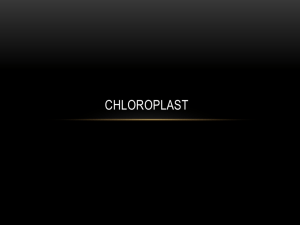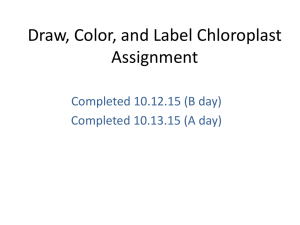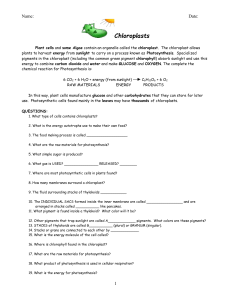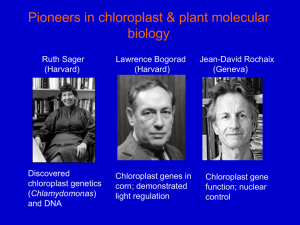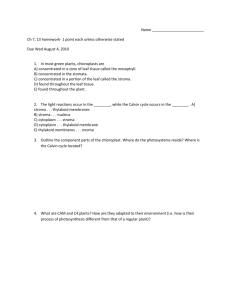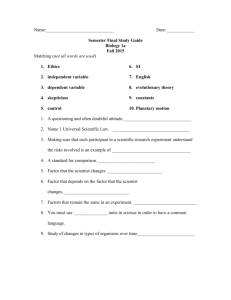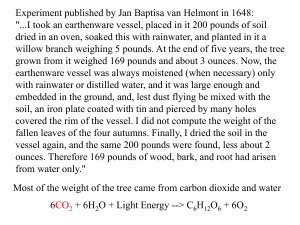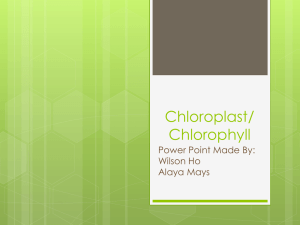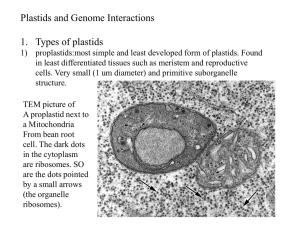chl - Govt College Aron
advertisement
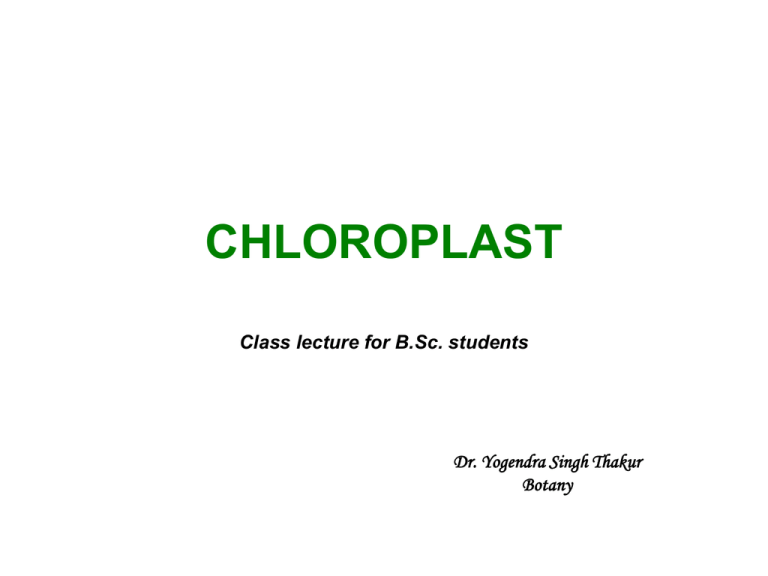
CHLOROPLAST Class lecture for B.Sc. students Dr. Yogendra Singh Thakur Botany WHY ARE PLANTS GREEN? Different wavelengths of visible light are seen by the human eye as different colors. Gamma rays X-rays UV Infrared Visible light Wavelength (nm) Microwaves Radio waves WHY ARE PLANTS GREEN? Plant Cells have Green Chloroplasts The thylakoid membrane of the chloroplast is impregnated with photosynthetic pigments (i.e., chlorophylls, carotenoids). THE COLOR OF LIGHT SEEN IS THE COLOR NOT ABSORBED • Chloroplasts absorb light energy and convert it to chemical energy Light Reflected light Transmitted light Chloroplast Absorbed light • The location and structure of chloroplasts Chloroplast LEAF CROSS SECTION MESOPHYLL CELL LEAF Mesophyll CHLOROPLAST Intermembrane space Outer membrane Granum Grana Stroma Inner membrane Stroma Thylakoid Thylakoid compartment Chloroplasts It is a type of plastids Plastids: A group of plant and algal membranebound organelles that include Amyloplasts, Chromoplasts and Chloroplasts. Amyloplasts : (Amylo= starch) colorless plastids that store starch; found in roots and tubers. Chromoplasts : (chromo=color) plastids containing pigments other than chlorophyll; responsible for the orange and yellow color of fruits, flowers and autumn leaves. Chloroplasts: (Chloro= green) Chlorophyll-containing plastids which are the sites of photosynthesis •Found in eukaryotic algae, leaves and other green plant organs •Are lens-shaped and measure about 2µm by 5µm •Are dynamic structures that change shape, move and divide. Ultra structure of chloroplast • • • • • • • • • 1. Chloroplast membrane 2. Stroma or Matrix 3.Grana 4. Lamellae Stroma lamellae Grana lamellae- Thylakoid -chlorophyll- quantasomes 5. Osmiophilic granules 6. Ribosomes 7. DNA & RNA • Chlorophyll is found in the thylakoid membranes •Thylakoid membrane---one Quntosome---230chl molecules+4050 carotinoids • Thylakoids function in the steps of photosynthesis that initially convert light energy to chemical energy • Some thylakoids are stacked into grana Grana : (Singular: granum) Stacks of thylakoids in a chloroplast 3. Stroma: Photosynthetic reactions that convert carbon dioxide to sugar occur in the stroma. Stroma: Viscous fluid outside the thylakoids Photosynthetic unit -Quantasomes • Have two zones• 1. Peripheral zone- contains pigment molecules • 2. Middle or Energy zone • Chemical components:Chl. A, chl. B, Beta carotine, vialoxanthin, neoxanthin, plastoquinone a,b,c, vitamin k, phaspholipids, nitrogen, Mn, Fe, Cu etc. Chemical Composition • • • • • • • • • • Protein- 35-55% Lipids-20-30% Carbohydrates- 4-7% Pigments – 9-13% Osmiophilic granules Few amount- Nucleic acid, Vitamin K and E, Mg, Fe, Cu, Mn, Zn, P etc. 70s Ribosomes, Enzymes, RNA -5% DNA • Chloroplast DNA: • Plastid DNAs are circular duplex molecules with a total length of 45 mm. • Non Histone • Each plastid consists of 6-30 copies of circular DNAs and most of them are in super coiled state. • Based on its genomic size, it has been calculated that each cp DNA molecule can code for about 110-120 proteins. Chloroplast Pigments • Pigments:- Chlorophyll and Carotinoides. • 1. Chlorophyll- chl. a,b,c,d,e • Bacteriochlorophyll a and b • Bacteropviridin • • • Chlorophyll:- a-C55H72O5N4Mg b-C55H72O6N4Mg Chl.- Porphyrin head & Hydrocarbon chain 2. Carotenoids Carotins Xanthophylls • C40H56 Function • • • • • Photosynthesis Production site of assimilatory power Participate in Photorespiration Protein synthesis Lipid metabolism Cellular respiration Cellulose Starch Other organic compounds Origin of chloroplsat: • Endosymbiotic theory • Autonoumous theory
